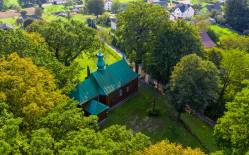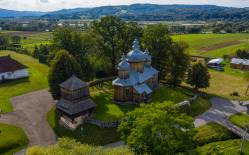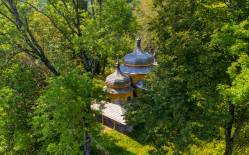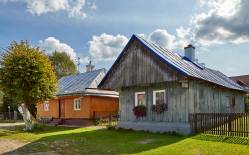The first record of the parish dates from the 1400s. The church was relocated in 1859. Before WWII this was a Greek Catholic tserkva of Sobor of the Most Holy Mother of God. Later the prophet Elijah was added as another patron of the tserkva.
The three-part log building, oriented towards the east, is clad with vertical wood planks. The narthex is not distinguishable in the silhouette of the building. The chancel is closed with a straight wall, and the sacristy is in the northern side. The gable roofs are covered with metal sheets. A turret can be seen on the roof above the nave. A zvonnitsa-type bell tower stands nearby. One of the bells is dated to 1668, the other two bells were made in the 1800s. The tserkva is surrounded with a stone wall.
Inside we can see flat ceilings, and a gallery supported by four wooden pillars. The neo-Baroque iconostasis, as old as the church, holds icons from the early 20th century. The contemporary altar frontals depict the burial of Saint Nicholas, entry of the Most Holy Theotokos into the Temple, Christ teaching in the temple, and the Massacre of the Innocents. The Royal Doors feature a motif of acanthus runners and four medallions of the Evangelists. The Deacons’ Doors bear circular images of Aaron and Melchizedek. The altar in the chancel features a canopy and a frontal with depiction of the sacrifice of Abraham.
In 1945, people living in Hłomcza, including the last Greek Catholic priest, father Mikołaj Aronc, were relocated to Ukraine, the region of Ternopil. After that the tserkva was acquired by the Roman Catholic Church. Those left behind in the village included only a few mixed Polish-Ukrainian families. After 1956 they initiated efforts to have the Greek-Catholic parish reinstated here, which eventually happened only in 1990. This is when Prophet Elijah was added as the second patron of the tserkva.
The unique features of this place include the two ancient oaks, which by the local people were named Cyril and Methodius. According to dendrology experts they are 800 and 700 years old, respectively. During WWII, when the German-Soviet border ran along the river San, the oak named Cyril was used by Germans as a watch post.
Photo: Krystian Kłysewicz
Gallery

Recommended venues on the Trail







This website has been modernized with the financial support of the European Union under the Cross-Border Cooperation Programme Poland-Belarus-Ukraine 2014-2020. The responsibility for its content lies solely with the Podkarpackie Regional Tourism Board and cannot, in any case, be treated as a reflection of the position of the European Union, the Managing Authority, or the Joint Technical Secretariat of the Cross-Border Cooperation Programme Poland-Belarus-Ukraine 2014-2020.









